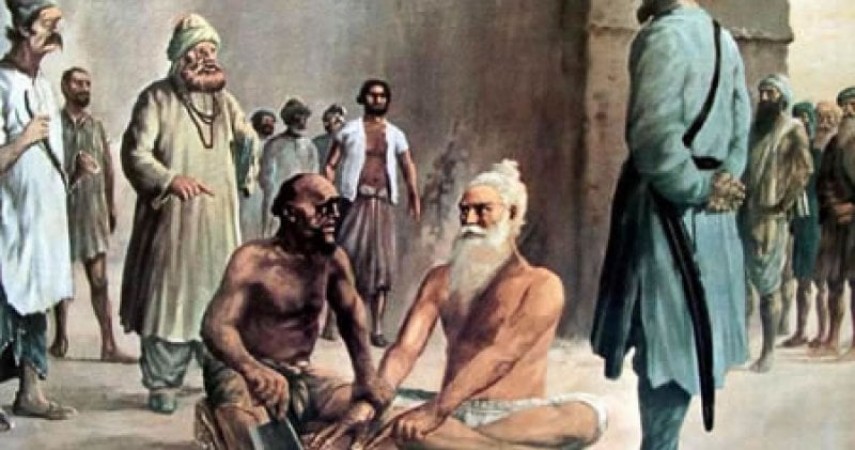
Bhai Mani Singh Shaheed was a great Sikh personality of the 18th century and occupies a much-esteemed position in Sikh history as one of the most famous martyrs of the Sikh faith. Bhai Mani Singh was a childhood companion of Guru Gobind Singh Ji. He assumed the control and steered the course of the Sikh's destiny at a very critical stage in Sikh’s history.
Bhai Mani Singh Ji was a leader, a scholar, and a devoted Sikh who gave his life to protect the honor of the Sikh country and faith. The daily Sikh Ardass (prayer) now includes a reference to the nature of his martyrdom in which he was cut apart joint by joint.
Also Read: Guru Nanak Dev Ji: The Founder Of Sikhism
Bhai Mani Singh was born in Alipur village, Punjab which is now situated in Pakistan in a Rajput Family. Bhai Mani Singh's name was Mania (Mani Ram). Bhai Mani Singh was from a distinguished family of Sikh warriors. His brother, Bhai Dayala attained martyrdom at Delhi with Guru Tegh Bahadur.
Bhai Mani Singh spent a considerable part of his life in service at Harmandir Sahib in Amritsar. He was one of the 12 sons of Mai Das. His grandfather was Bhai Bhaloo Rai, a reputable warrior, who was a soldier in Guru Hargobind's army who took part in all the battles fought by Guru Hargobind Sahib against the Mughal attackers.
Also Read: Bibi Nanki Ji: Founder Of Sikh Faith
Bhai Mani Singh, his grandfather, eleven brothers, and seven of his ten sons died in battles fought on behalf of the Guru.
Bhai Mani Singh acted as scribe when Guru Gobind Singh Ji dictated Sri Guru Granth Sahib.
Bhai Sahib collected the Gurbani (Literally "Word of the Guru") of Guru Gobind Singh Ji and compiled it in the form of Dasam Granth (Book of the Tenth Guru). The writings included in the Dasam Granth were composed at different times by the Guru himself and his band of 52 poets.
Japji Sahib Da Garb Ganjni Teeka, written by Bhai Sahib, is a translation and explanation of another work. He added to the first of Bhai Gurdas' Vaars to create Gyan Ratnavali, a biography of Guru Nanak. An expansion of Bhai Gurdas's eleventh Vaar by Mani Singh, the Bhagat Ratnawali (also known as Sikhan di Baghat Mala), provides a list of notable Sikhs up to the time of Guru Hargobind.
Also Read: Guru Nanak Dev Ji: Udasis (Spiritual Journeys)
Bhai Singh is credited for writing the Ardas (Supplication) in its current form while serving as a Granthi of Darbar Sahib in the Golden Temple. He is also credited with beginning the custom of including the deeds of many Gursikhs in the supplication.
Additionally, he had the sacred Sikh scriptures translated into numerous copies, which were then transported to various preaching locations in India. He also instructed the Sikhs in Gurbani reading and its philosophy.
Also Read: Guru Tegh Bahadur Ji: Hind Di Chaadar
When Bandi Chhor Divas were being celebrated at the Harmandir Sahib in around 1737, Bhai Mani Singh approached the governor of Lahore, Zakariya Khan, for permission to hold the Diwali festival. On payment of a Rs. 5,000 tribute, permission was granted. He hoped that he would be able to cover the cost of the offerings the Sikhs who were asked to attend would make. Of all people, he gave initiations to the Sikhs. Along with Diwan Lakhpat Rai, the governor had other objectives, and he gave his troops secret orders to surprise the Sikhs during the celebration. When Bhai Mani Singh learned of the plot, he sent messages instructing the Sikhs not to attend. Due to the unnecessary presence of a sizable military force and suspicious officer movements, the Sikhs who did arrive were forced to depart. As a result, no money could be raised or given to the government, and Bhai Mani Singh's execution was ordered.
Also Read: Guru Tegh Bahadur Ji: Sacrifice for Kashmiri Pandit
In shackles, Bhai Mani Singh was transported to Lahore. Bhai Mani Singh was forced to convert to Islam after he was unable to pay the fine and dues he had pledged to pay the Mughals (to organize the event legally). He was told to be dismembered since he wouldn't abandon his principles. When the executioner started to start with his wrists, Bhai Mani Singh gently reminded him of the sentence, telling him to begin with the joints in his hands instead.
Bhai Mani Singh was executed at Nakhaas Chowk, Lahore in December 1738 ca. The Nakhaas Chowk has since been known as Shaheed Ganj - the place of martyrdom. Another commemorative shrine built in the late 1900s at a Gurdwara near Laungoval in the ruins of village Kamboval marks Bhai Mani Singh's hometown and place of birth. By 1737, the Mughal government of Lahore had strictly prohibited the Sikhs to visit Amritsar and bathe in the holy tank. Zakariya Khan died in 1745.